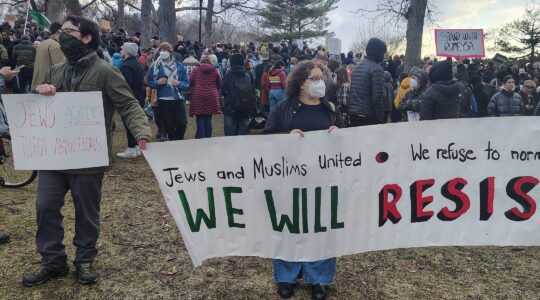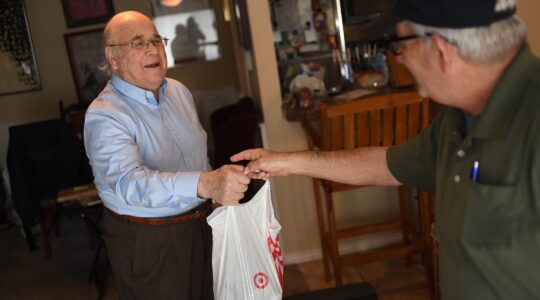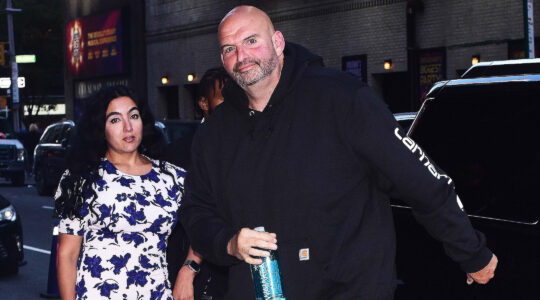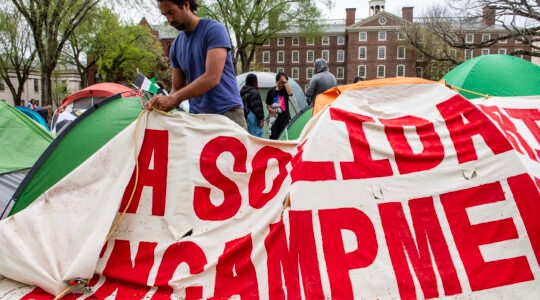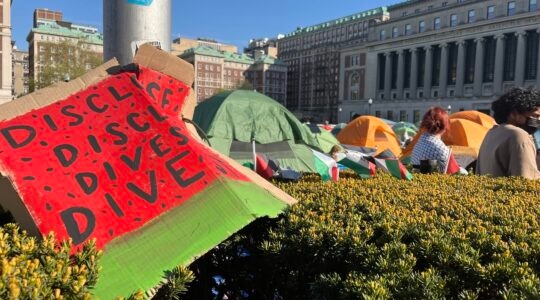WHITE PLAINS, N.Y. (JTA) — Alexis Kashar was listening intently to the speaker at a recent Jewish federation event in this New York City suburb.
A closer look revealed that her eyes were trained not on the podium but on Naomi Brunnlehrman, who was seated in front of the speaker translating the lecture into American Sign Language.
Kashar, 43, a longtime civil rights lawyer, has been deaf since birth. Five years ago she and Brunnlehrman, co-founder of the Jewish Deaf Resource Center, asked the UJA-Federation of New York to subsidize ASL interpreters, so Kashar and other deaf Jews in the New York area could take part in Jewish communal events.
In 2009, the federation began granting $5,000 a year to the center.
“I was ready to quit the Jewish community when I met Naomi,” said Kashar, who lip reads and speaks but works with an interpreter.
Kashar is involved with the Jewish federation, she says, in an effort to increase services for the Jewish deaf and hard of hearing.
Kashar has three hearing children and was concerned about their Jewish future.
“I realized if I don’t have access, my children won’t either,” she said. “Why would I take them to synagogue when I have to sit there and have no idea what’s going on?”
An estimated 50,000 deaf Jews live in the United States, according to advocacy groups for the Jewish deaf. Insiders say most are not involved in Jewish life, mainly because it’s just too difficult. There are a handful of synagogues for the deaf and half a dozen deaf rabbis, and several national and local social and cultural organizations serve the Jewish deaf.
In the past decade, however, mainstream Jewish institutions and synagogues have begun providing ASL interpreters and/or assistive listening devices, allowing deaf and hard-of-hearing Jews to take part in mainstream Jewish life instead of being segregated. The numbers of such pioneering institutions, however, remain quite small, experts say.
“You can count them on one hand,” said Jeffrey Lichtman, director of Yachad, the National Jewish Council for Disabilities, which operates under the auspices of the Orthodox Union.
Traditionally, the Jewish deaf were not treated as full members of the community. Their testimony was not accepted in religious courts, and they were exempt from commandments that involve listening, which means they were not called to the Torah or even taught Hebrew.
That is changing, experts say, but very slowly.
“We don’t expect all synagogues to have all their services interpreted, but maybe once a month or for the holidays,” Lichtman told JTA. “It’s no different from making accommodations for the physically challenged or the blind. If you don’t, you are effectively saying these people are not welcome.”
Funding for inclusion is increasing mainly because the Jewish deaf community, like the American deaf community in general, is in transition. There is a growing divide between those who are more comfortable in deaf-only settings — usually older people who grew up signing and comprise the bulk of membership in deaf congregations — and younger deaf Jews who are more at ease in hearing society.
The change is largely due to technology, especially the prevalence of cochlear implants that permit limited hearing, according to Lichtman.
“Ten years ago the deaf community had a strong component that did not want inclusion. They wanted their own separate community,” he said. “Today, people who were not interested in inclusion in the past are now much more interested, especially for their children.”
Avi Jacob, 21, wears hearing aids and does not sign.
“We wanted to get him to speak, so he could be included in the typical Jewish world,” said his mother, Batya Jacob, program director at Our Way, Yachad’s department for the Jewish deaf.
Avi Jacob attended Jewish day school and is now a senior at Yeshiva University, where a note-taker takes notes for him in secular classes. In his Jewish courses, Batya says, public funding is not available, so he borrows friends’ notes.
“He does not consider himself disabled,” she said.
Congregation Bene Shalom in Skokie, Ill., is among a handful of synagogues founded to serve deaf Jews and their families. Rabbi Douglas Goldhamer says that services, meetings and his counseling sessions are voiced and signed.
When the cantor sings in Hebrew, a choir “translates” the prayers into ASL. Clergy don’t face the ark during prayers when it is customary to do so because deaf congregants would be unable to see what they are saying. Some liberal synagogues flash lights on and off to signal certain parts of the service, but Bene Shalom does not use electricity on Shabbat.
Goldhamer says that more young deaf Jews attend hearing synagogues than their parents did. If there is no interpreter, they may go with hearing friends; young deaf people today tend to have more hearing friends. Or they might get together with a few other deaf Jews and hire their own interpreter.
“They’re asserting their rights more,” Goldhamer said.
In Columbus, Ohio, the local Jewish federation gives $3,000 a year for deaf services, with interpreted High Holidays services rotating to different synagogues each year. The federations in New York, Boston and Washington also give money for interpreters.
At Temple Israel in Columbus, which has eight or nine deaf regulars, a deaf member in his 80s celebrated his bar mitzvah seven years ago. The ceremony was interpreted into ASL.
“He told me that when he was growing up, there wasn’t a place for him in the Jewish world,” said the synagogue’s executive director, Elaine Tenenbuam. “There are deaf people in every Jewish community, but they don’t participate. They’ve stepped away from the community because it doesn’t provide for them.”
It’s not always a young vs. old scenario. In many cases, older deaf Jews had parents who insisted on mainstreaming them.
Sharon Ann Dror, the founder and president of the Jewish Deaf Community Center in Los Angeles, “grew up oral” with hearing parents who didn’t want her or her hard-of-hearing sister segregated.
But when she went to college and learned ASL, Dror suddenly realized how much she’d been missing, she told JTA via online chat.
“Instead of getting a few sentences in the hearing world from my friends, I can have a real meaningful dialogue with my deaf community,” she wrote.
Dror reads lips and speaks well, but her three deaf children don’t speak at all, relying instead on signing. Her oldest, 19-year-old Joshua Soudakoff, is a Lubavitcher who teaches Torah to other deaf Jews using ASL. Videos of his weekly Torah lessons, conducted in sign, are at Jewishdeafmm.org.
Soudakoff writes that he feels more comfortable within the deaf community, and that hearing people often don’t understand what he’s trying to say and just nod along. he finds it frustrating.
“They don’t understand that deafness is a physical condition, not a mental issue,” he said.
In November, the Jewish Federations of North America paid for Alexis Kashar and Naomi Brunnlehrman to address the International Lions of Judah conference in New Orleans, held immediately after the federations’ General Assembly. Kashar says that’s good, but much more needs to be done.
“It’s our mission to take this nationally,” she said. “We need to bring the deaf Jews back home.”
JTA has documented Jewish history in real-time for over a century. Keep our journalism strong by joining us in supporting independent, award-winning reporting.
